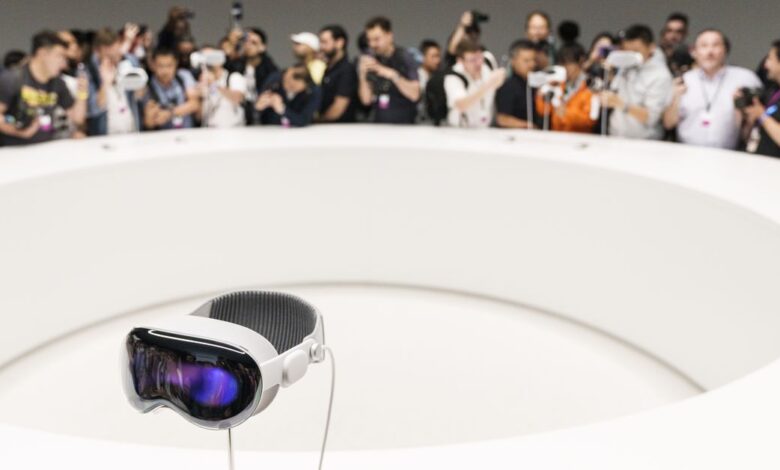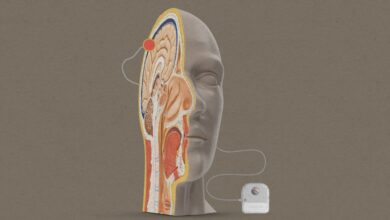What wearing Apple’s Vision Pro headset does to our brains

The tech world got very fired up in 2013 when Google released a video of a wild concept. It showed a first-person view of a guy walking around Manhattan, texting friends, following map instructions, making a video call.
It was all pretty normal — except instead of pulling a phone out of his pocket, the texts, maps, and videos appeared to float in front of his eyes.
The gadget that would make all this possible was called Google Glass, a $1,500 device you wore like glasses, with a tiny display placed in front of one eye and a camera that could see (and record) everything you could see. You could theoretically go about your daily routine, giving voice commands to the internet-connected headset and making bright distracting screens a thing of the past.
It’s a dream the tech industry is still chasing. There are a few names for this concept. Mixed reality and augmented reality are the generic ones. Metaverse, popularized by Mark Zuckerberg when he renamed his company Meta, is the one you’ve probably heard of the most. Spatial computing is the name Apple recently coined with its $3,500 Vision Pro headset, which goes on sale February 2.
Whether it succeeds or flops, as Google Glass ultimately did, the Apple Vision Pro will bring lots of fresh attention to the mixed reality concept. How that attention shapes the development of the technology could dictate how we use computers in the future. Apple reportedly sold as many as 200,000 units in the Vision Pro presale, a sign that at least a few people are interested in spending a lot of money to see what Apple thinks we eventually should do. Will we all walk around town wearing headsets and taking video calls while we watch the sunset? Or will a small group of us end up playing video games in a completely — and probably lonely — virtual world?
It’s not clear what Apple thinks you should do with its mixed reality headset right now. The company’s marketing materials seem to suggest you should use it in your living room like a fancy TV that can also make futuristic video calls. The device has not one but 12 cameras on the front of it — not to mention a LiDAR sensor, six microphones, and a TrueDepth camera that can scan faces. Like the Meta Quest, the new Apple headset can do fully immersive virtual reality, but it’s also capable of combining virtual elements with images of the real world, kind of like the Google Glass concept did.
But whereas Google Glass let viewers look out at the real world with minimal interference, the Apple Vision Pro headset essentially turns the world into a giant screen. Inside the headset there are two 4K micro-OLED screens with a staggering 23 million pixels to recreate the real world outside the wearer as a virtual one. All those cameras, sensors, and screens combine to create the headset’s marquee feature, one that truly differentiates it from past smart glasses: real-time passthrough video.
Passthrough, which also exists on the Meta Quest 3, allows the wearer to see the real world while wearing the goggles. Put simply, your eyes seem to pass right through the opaque front of the headset so you can see the room you’re sitting in and even interact with other humans. It’s also a way to get a taste of that Google Glass fantasy, where you can walk around with your face computer, looking at a world with a useful digital layer superimposed upon it. The big problem, of course, is that nobody knows how looking at the world through a screen and only a screen could screw up your brain and your relationship with society.
Apple’s vision and its inevitable distortions
While it’s tempting to wax philosophical and start talking about how this echoes Plato’s Allegory of the Cave, there are more practical questions about what the Apple Vision Pro’s arrival will mean for the future of computing. Many of us are already using computers — namely by craning our necks to look down at the miraculous slabs of glass we call smartphones — almost all the time. The smartphone freed computing from the computer and turned it into something we can carry with us everywhere. They’ve already changed how we see and interact with the real world, as anyone who’s watched someone disappear into their iPhone knows. So if a radically new device, like a headset or set of glasses, becomes the dominant computing technology, it will change how we see the world. The question is how.
:no_upscale()/cdn.vox-cdn.com/uploads/chorus_asset/file/25258927/GettyImages_1258467378.jpg)
A group of researchers at Stanford’s Virtual Human Interaction Lab have been trying to figure out the answer. The researchers tested out the Apple Vision Pro alongside a range of other headsets with passthrough video capabilities, including the Meta Quest 3. The researchers explored the psychological impacts of living life in passthrough video by wearing these headsets for hours at a time, even venturing out in public to try things like riding a bike or eating a meal while seeing through a computer. They shared their findings in a new paper that reads like a cautionary tale for anyone considering wearing the Vision Pro anywhere but the privacy of their own home.
One big problem with the passthrough video technology is that cameras — even ones as high-tech as those in the Vision Pro — don’t see the way human eyes see. The cameras introduce distortion and lack the remarkable high resolution in which our brains are capable of seeing the world. What that means is that everything looks mostly real, but not quite.
The Stanford researchers explained that objects close to your face end up looking unusually large in passthrough, so eating with a fork is a real nightmare. Headset wearers also tended to underestimate distances, which makes pressing elevator buttons a fun guessing game. And because nothing looks quite right, headset wearers “tended to move tentatively and slowly while walking.” You can almost picture them looking lost and overwhelmed at all times.
The time spent observing the world through the headset isn’t the most alarming part of the experiment. It’s once they took the headsets off that the researchers’ minds really started playing tricks on them. The human brain can generally adapt to changes in vision and effectively correct for any distortion, and it’s possible that Apple could push software updates that solve the distortion problem. But when the headsets came off, it took time for the researchers’ brains to return to normal, so they’d misjudge distances again. Many also reported symptoms of simulator sickness — nausea, dizziness, headaches — that will sound familiar to anyone who’s spent much time using a VR headset.
Then there are the social effects. While wearing Google Glass in public invited ridicule a decade ago, headsets like the Meta Quest and, soon enough, the Apple Vision Pro will look more familiar to present-day observers. You don’t see people wearing them in public a lot, but it’s not out of the question. The researchers trying to live life with passthrough-capable headsets said they didn’t experience many negative reactions to what they were doing. Instead, they felt incredibly self-conscious to be navigating the world through goggles, and some experienced something called “social absence.” The researchers described this sensation in the paper: “People in the real world simply felt less real. … Being in public could sometimes feel more like watching TV than interacting face-to-face. It was often embarrassing to interact with strangers while wearing a headset.”
Jeremy Bailenson, who led the study and is the founding director of Stanford’s VHIL, has spent the last 25 years studying the psychological effects of virtual and mixed reality. He doesn’t think this technology should be used all day long or even every day, in part because of how socially isolating it can be. His lab has developed a framework it calls DICE. That’s an acronym for “dangerous, impossible, counterproductive, or expensive” — the use cases that make the most sense for employing VR and mixed reality technology.
“Training firefighters, rehabilitating stroke victims, learning art history via sculpture museums, time-traveling to understand climate change are all examples that fit squarely in DICE,” Bailenson told Vox. “Checking your email, watching movies, and general office work do not. Let’s use the medium when it earns its keep.”
The inevitable growing pains of technological process
Setting aside the Plato’s cave of it all, it’s obvious that, on a practical level, this new future of face computers is, at the very least, going to be awkward for everyone.
:no_upscale()/cdn.vox-cdn.com/uploads/chorus_asset/file/25258928/GettyImages_1496266033.jpg)
The Apple Vision Pro may be a marvel of modern industrial design befitting its four-figure price tag, but it still looks like a gaudy set of ski goggles. Apple even tried to make them feel less awkward for those not wearing them with a feature called EyeSight that shows the eyes of the wearer on a display built into the front side of the headset, but people still think it’s creepy. Meanwhile, in an effort to make the headset less bulky, Apple gave it a tethered external battery that people have to carry in their pockets, ensuring a bit of a cyborg vibe for the wearer’s outfit. It’s all far from natural.
David Lindlbauer, a professor who leads the Augmented Perception Lab at Carnegie Mellon University, doubts that we’ll see people talking to their friends while wearing Vision Pro headsets at coffee shops in the near future. It’s simply strange to talk to someone whose face you can’t fully see.
“Socially, we’re not used to it,” Lindlbauer said. “And I don’t think we even know if we ever want to get used to this asymmetry in a communication where I can see that I’m me, aware of the device, can see your face, can see all your mimics, all your gestures, and you only see a fraction of it.”
But the situation might be temporary. Let’s not forget that it wasn’t that long ago when wireless earbuds, including Apple AirPods, meant that people were standing on street corners seemingly talking to no one when in fact they were on a phone call. If the hardware continues to get better and smaller, we might see people standing on street corners wearing regular-looking eyeglasses, staring off into space, tapping their fingers in the air because their glasses are projecting a digital layer onto the physical world. They could be looking for a friend down the street while simultaneously watching a TikTok video and talking to a voice assistant. That kind of thing will definitely look unusual the first time you see it.
This is still the big dream for computing. Google Glass did not end up being the mixed reality device that changed the world, but you have to assume that Apple is investing billions in mixed reality. It will likely take years for the Vision Pro and its successors to take off like the iPhone or iPad, but one day, Apple wants to see how people use a headset that turns your entire world into a computer. That’s actually what Apple Vision Pro promises to do. “The era of spatial computing has arrived,” said Apple CEO Tim Cook in early January. The Vision Pro, he said, “will redefine how we connect, create, and explore.” But for now, the catch is it will probably just do those things while you’re inside your home.
Mixed reality — or spatial computing or whatever you want to call it — is still an experiment. We’re not ready for it on a number of levels. The hardware isn’t there yet or we wouldn’t have to wear heavy ski goggle-shaped headsets and carry battery packs in our pockets. Perhaps if the display technology could replicate the resolution of human eyesight with no distortion or limitations, we would avoid all the negative consequences of passthrough video. The world will also need to ease into the idea of face computers, just like it had to get used to the idea of personal computers, and just like we’re still getting used to the ubiquity of smartphones. And our brains will need to do some adjusting to understand where the virtual world ends and the real one begins.
So don’t expect to run into too many people wearing Vision Pro headsets in public just yet. Even Apple seems to be gently discouraging the idea. Most of the promotional material for the Vision Pro sets it up as a productivity device (a way to make your spreadsheets look like they’re in your living room) or an entertainment system (a way to watch movies in 3D on screens the size of your entire field of vision, although Netflix, YouTube, and others will not have apps ready when the headset launches). So it’s chiefly an indoor toy. Tech analyst Benedict Evans noticed something funny in the videos Apple released to developers last summer to showcase what the Vision Pro can do: “Apple doesn’t show this being used outdoors at all, despite that apparently perfect pass-through. One Apple video clip ends with someone putting it down to go outside.”
It will be a while before we get that magical headset, the lightweight glasses that put a computer screen on your world. Lindlbauer, the Carnegie Mellon professor, doesn’t think we’ll still be using smartphones in 15 years. What we will use will be more exciting, and how that technology will work depends on what people do with gadgets like the Apple Vision Pro. If people who buy the headset don’t like seeing the world through a screen, watching the moments of their lives fly by like shadows on the wall of a cave, someone will just have to build something better. And hopefully cheaper.
$5/month
$10/month
$25/month
$50/month
Other
Yes, I’ll give $5/month
Yes, I’ll give $5/month



